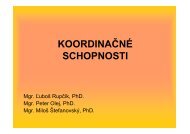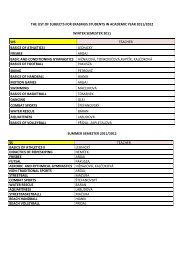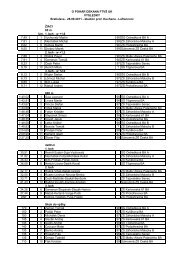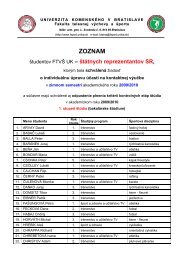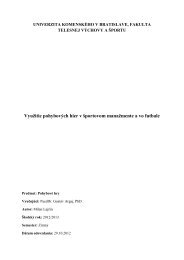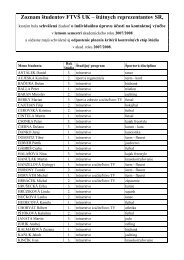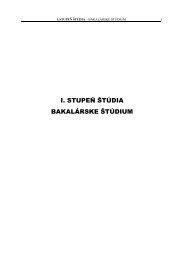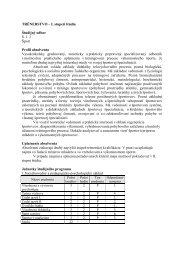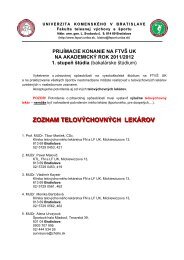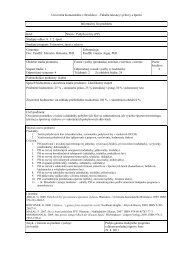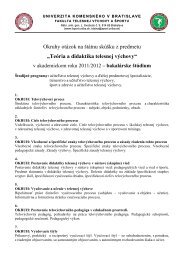acta facultatis educationis physicae universitatis comenianae
acta facultatis educationis physicae universitatis comenianae
acta facultatis educationis physicae universitatis comenianae
You also want an ePaper? Increase the reach of your titles
YUMPU automatically turns print PDFs into web optimized ePapers that Google loves.
Assessment of pedalling techniques on a bicycle depending on intensity of training load<br />
41<br />
ASSESSMENT OF PEDALLING TECHNIQUES ON A BICYCLE<br />
DEPENDING ON INTENSITY OF TRAINING LOAD<br />
Juraj Karas<br />
Faculty of Physical Education and Sports, Comenius University in Bratislava, Slovakia<br />
Summary: The aim of the study was to compare the cyclical fluctuations propulsive force<br />
produced during pedalling as a criterion for the assessment of technique in cyclists, and noncyclist<br />
at different exercise intensities at frequency of 90 revolutions per minute. Twenty<br />
competitive road cyclists and 20 fit non-cyclists volunteered to participate in the study. Both<br />
groups underwent in random order one-minute exercise on the isokinetic cycle ergometer at<br />
intensity of 100, 200 and 300 watt, and at the end also a 10-second maximum effort bout at<br />
frequency of 90 revolutions per minute. Propulsive force (the force transmitted through the<br />
chain to the braked flywheel) was recorded during the tests. From each minute exercise the<br />
average values of minimum, maximum and average force of 360-degree pedalling cycle were<br />
obtained. In addition equality coefficient of pedalling as a percent difference between maximum,<br />
minimum force, and average force was calculated. Results showed significant differences<br />
(p < 0,05) in equality pedalling coefficient during 200-watt load and in 300-watt load. Differences<br />
were found for those loads, which cyclists prefer in their training and racing. The results<br />
proved a specific effect of training on pedalling technique depending on the training intensity<br />
of preferred pedalling frequencies.<br />
Key words: equality pedalling coefficient, exercise intensity, pedalling technique<br />
Introduction<br />
Good performance in endurance sports depends not only on maximum aerobic power,<br />
but also sufficiently high mechanical efficiency of muscular work. Its level is determined<br />
by the efficiency of converting energy sources (fat and sugar) into usable energy in muscle<br />
cells macroergic phosphates (ATP and CP), as well as the effect of its further conversion into<br />
mechanical work of muscle contraction itself. An important factor that affects the mechanical<br />
efficiency is technique. Its significance is the greater; the more technically demanding movement<br />
is implemented.<br />
Even though pedalling a bicycle is one of the relatively simple and low-tech physical<br />
activities, differences between road cyclists and non-cyclists moderately fit in mechanical<br />
efficiency exist. While individuals of the general population reach the gross mechanical<br />
efficiency of approximately 20 % (Hamid et al., 2005), for the trained cyclists values up to<br />
about 25 % are reported (Burke, 2003).<br />
Under the technique in cycling we understand way in which the force produced by leg<br />
muscles is transmitted to pedal a bicycle. One of the factors pedalling technique can be<br />
Acta Facultatis Educationis Physicae Universitatis Comenianae LII/I



